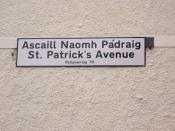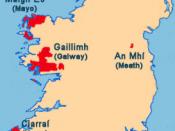Professor Kuipers
Anthropology 4
Irish Gaelic: A Brief Linguistic Analysis
A member of the Goidelic group of Celtic Languages, Irish Gaelic shares many of the linguistic features of this family that make it distinct from other languages that share its Indo-European origins. Often just called Gaelic by people outside of Ireland, the Irish refer to the language as Irish Gaelic, or simply Irish to distinguish it from Scott and Manx which are also forms of Gaelic, as well as to emphasize its status as one of the national languages of Ireland (Gaeilge, "History"). A very ancient language, the popularity of Irish Gaelic has had many ups and downs correlating with Ireland's political situation. Today, Irish has about 1.57 million speakers in Ireland and a few other speakers in the U.K., Australia, and the U.S.. The heaviest concentration of Irish speakers are in specific towns and villages in Ireland known as GaeltachtaÃÂ, mostly on the west coast (Gaeilge, "The Gaeltacht").
Though there are several different dialects of Irish, since the 1958 an official standard of Irish, "An Caighdeán Oifigiúil," was introduced that is now the version taught in schools and spoken on the radio and television (Gaelige, "Today"). This standard Irish is supposed to be easier to learn and reduce the disparity between the way people speak Irish Gaelic and how it looks in writing. Although written Irish draws from the same alphabet as English, pronunciation of letter combinations and sounds are often very different from how it looks on paper to an English speaker. For example, an s followed by a slender vowel is pronounced 'sh' and the bh combination indicates a 'v' sound, so that the Irish name "Siobhan" is actually pronounced "Shavonne".
The Irish sound system is made up of different consonant and vowel...


